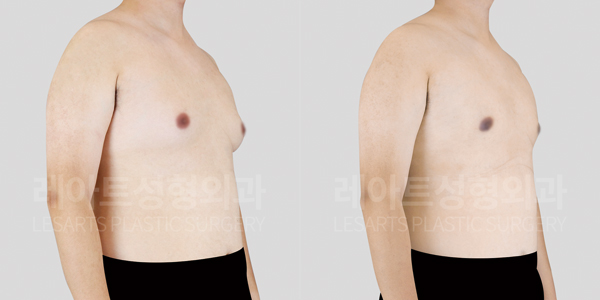If male gynecomastia surgery cannot be resolved through weight loss?

Information
- Age : mid 30’s
- Height : 174cm
- Weight : 82kg
- BMI : 27
Surgical site
- surgical site : gynecomastia, side chest liposuction
- grade : 2-A
Are you a man with an unusually large chest?
Doesn’t seem to shrink despite exercise or diet?
In that case, the development of glandular tissue should be suspected.
When you first recognize gynecomastia symptoms, you might initially think, “Wouldn’t weight loss help improve the condition?”
However, even with dieting, in the case of true gynecomastia, where glandular tissue has developed, you may notice that while fat around the chest area reduces to some extent, the chest line can appear even more prominent.
Of course, while gynecomastia itself doesn’t typically cause significant physical symptoms, the biggest issue for most is the aesthetic concern.
However, there are various causes of gynecomastia, some of which require treatment and management, so seeking medical advice is an important step to consider.
Let me now explain the results of gynecomastia treatment by showing the before-and-after photos of a patient.

[Lesarts plastic surgery before gynecomastia surgery]
This patient is in his mid-30s and has been overweight since his teenage years, during which he first became aware of his gynecomastia symptoms.
Especially after joining the military, he experienced not only an aesthetic complex due to his chest size but also psychological discomfort. Despite consistently exercising and trying to manage his weight, he saw no change in the size of his chest, which caused ongoing stress.
Ultimately, to resolve his gynecomastia symptoms, he decided to undergo surgery and visited our clinic.

[Lesarts plastic surgery before gynecomastia surgery]
The patient’s gynecomastia symptoms were visibly apparent, with a large and protruding chest size.
To determine the exact cause of the gynecomastia, an ultrasound was performed, revealing excessive glandular tissue in both breasts. The patient was diagnosed with true gynecomastia, corresponding to Simon Grade 2A.
Additionally, there was some fat accumulation around the side of the chest, which made liposuction necessary.
We explained to the patient that a combination of glandular tissue excision (mammoplasty) to reduce chest size, along with liposuction to remove fat from the sides and lower part of the chest, would be needed to correct the shape of the chest.
Furthermore, to ensure that the chest does not become sunken or asymmetrical after the gland excision, we planned a tissue rearrangement surgery to create a firm, masculine chest contour.
Since the patient has slightly less skin elasticity, we advised him to wear compression garments more carefully and for a longer period than usual after the surgery.
We also explained the importance of regular follow-up visits.
Next, I will show the pre- and 3-month post-surgery photos for a detailed explanation.

[Lesarts plastic surgery before&after gynecomastia surgery(Taken under the same conditions 3 months after gynecomastia surgery.)]

[Lesarts plastic surgery before&after gynecomastia surgery(Taken under the same conditions 3 months after gynecomastia surgery.)]
In the photos taken 3 months after the gynecomastia surgery, we can see that the chest shape, which was protruding due to glandular tissue and fat prior to the surgery, has been corrected through the gynecomastia procedure. The chest now has a normal, masculine appearance.
In particular, thanks to the patient following the advice to wear compression garments consistently after the surgery, the chest has recovered smoothly without any sagging issues.
Additionally, the fat in the lower chest and sides has been removed through liposuction, resulting in a more masculine, well-defined chest contour.

[3 month post-gynecomastia progress(Image for better understanding.)]

[3 month post-gynecomastia progress(Image for better understanding.)]
In the before and after photos taken while wearing a short-sleeved t-shirt, the effects of the surgery are more clearly visible.
Before the surgery, due to gynecomastia, the chest area appears protruding with a volume that could be somewhat embarrassing. However, after the removal of the glandular tissue that caused the gynecomastia, the chest protrusion issue has been resolved.
The upper body now gives a firm, toned look, resembling the appearance of someone who exercises regularly, and has been transformed into a more masculine physique.
At the 3-month post-surgery follow-up, the patient showed excellent overall results without issues such as adhesions or skin sagging. The patient’s satisfaction was also very high.
In particular, with well-formed masculine chest contours, if the patient continues with stretching and chest exercises as part of a systematic maintenance routine, even more satisfying results are expected.